
Following the fall of Robespierre and the end of the "Terror," the leaders of the French revolutionary government not taken to the scaffold were in an insecure position. They were almost all "regicides," yet were no longer able to use the threat of arrest and execution to maintain their positions. In an attempt to hold on to power, a new Constitution was passed in the Assembly on 23 September, 1795 which required that at least two thirds of the new assembly be made up of the former deputies.
There had been a resurgence of the Royalist party throughout France, in part because the downfall of the Terror gave the false impression that many people were ready to turn back the clock and reverse the bloody direction of the Revolution. Amongst the National Guard in Paris there was still a strong Royalist following. This, combined with the wealthier sections of Paris, produced a large group of discontents who had just been shut out of any influence or control of the Convention ruling France. The time seemed ripe to strike.
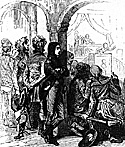 The Count d'Artois set sail from England and landed on the
channel island of the Ille Dieu in preparation for what he viewed as a
triumphant march on Paris as the new French king. In addition there is
some evidence that Pichigru was prepared to defect and bring his army
over to the Royalist cause. It all depended on seizing the seat of
government in Paris at the Tuileries.
The Count d'Artois set sail from England and landed on the
channel island of the Ille Dieu in preparation for what he viewed as a
triumphant march on Paris as the new French king. In addition there is
some evidence that Pichigru was prepared to defect and bring his army
over to the Royalist cause. It all depended on seizing the seat of
government in Paris at the Tuileries.
On the evening of 3 October, 1795 political rallies and organizational meetings were held around Paris by Royalist sympathizers. The largest of these was at the Odeon theater. The Directory, and specifically Barras, ordered the National Guard under Menou to disband the counter-revolutionary meeting. However, when he arrived, Menou backed down and retreated after meekly suggesting to the angry crowd that everyone go home.
Call for Bonaparte
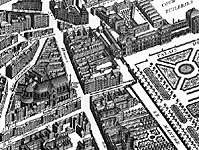 Things were reaching a crisis point, and Barras put out a
call for General Bonaparte to report to the Directory.
Things were reaching a crisis point, and Barras put out a
call for General Bonaparte to report to the Directory.
Large Map (very slow: 156K)
Jumbo Map (extremely slow: 707K)
Despite the best efforts of the messengers, Napoleon could not be found in his usual haunts. This prompted some to suggest that he might have gone over to the other side. It was at nine in the evening that Napoleon finally received the message and reported to the Tuileries. It turned out that Napoleon, anticipating the crisis, had been scouting out the situation all day and had already formed a plan.
He quickly began to deploy his troops around the Tuileries. If he could hold the bridges he could cut off all the rebel forces from the left (southern) bank of the Seine. The majority of his forces on this front took up positions at the Pont Royal. General Brune with a detachment took up positions north of the Palais Royal on the Rue Vivienne. The majority of his forces were placed near the stables of the Tuileries, where they could move out into the St. Honore area.
At midnight Napoleon dispatched Major Joachim Murat to seize the National Guard artillery at the Place de Sablons. With a squadron of cavalry (260 men), Murat arrived at the Place de Sablons at the same time as the National Guard soldiers. Threatening to saber them down where they stood, Murat's men were able to carry away the battery of pounder guns as the rebel infantry withdrew.
Morning of the thirteenth Vendemiaire (5 October), broke with the sounding of the tocsin. The Districts of Lepelletier and Filles St. Thomas in particular suddenly witnessed thousands of Royalist National Guard and citizens pouring into the streets. They were led by General Danican. Also commanding Royalist elements were Duhoux d'Hauterive and Laffont. While their forces were assembled by midmorning it was not until nearly four in the afternoon that the assault began. Their plan was to first assault from the north, then storm the bridges and catch the Republicans in between the two groups.
General Brune met the first assault near the Palais Royal. Bonaparte was there with him and ordered the howitzer section to open up with canister as the mob streamed down the Rue Vivienne. The stunned survivors retreated to a nearby theater for shelter. <>Main Assault
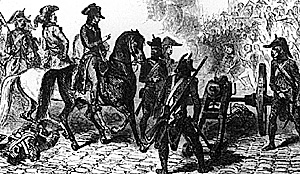 The main rebel assault would come down the Rue St.
Honore and past the St. Roch Church. The Church was being
used as an arsenal and assembly place for the final rush on the
Tuileries a mere two hundred yards away. As the Royalist
columns came down the narrow street they were surprised to see
Napoleon and his men waiting for them with two 8-pounder
cannon.
The main rebel assault would come down the Rue St.
Honore and past the St. Roch Church. The Church was being
used as an arsenal and assembly place for the final rush on the
Tuileries a mere two hundred yards away. As the Royalist
columns came down the narrow street they were surprised to see
Napoleon and his men waiting for them with two 8-pounder
cannon.
Several assaults were made trying to dislodge the artillery, but each time the rebels were hurled back leaving scores of men dead and wounded. The cannon were like giant shotguns spraying the crowd with canister.
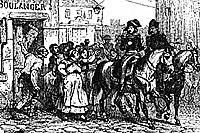 The Royalists then deployed their men in the houses and in
front of the Church and attempted to shoot their way past the
Government defenders. Napoleon personally sited the guns to
pummel the mob at the Church. Although they outnumbered the
Republicans, the powerful blasts of the cannon along with the
government sharpshooters proved too much for the Royalists
and within an hour the counterrevolution was effectively over.
The Royalists then deployed their men in the houses and in
front of the Church and attempted to shoot their way past the
Government defenders. Napoleon personally sited the guns to
pummel the mob at the Church. Although they outnumbered the
Republicans, the powerful blasts of the cannon along with the
government sharpshooters proved too much for the Royalists
and within an hour the counterrevolution was effectively over.
In the south Laffont had led three charges over the Pont Royal, but these too were turned back by the crossfire of a section of cannon. The final action of the day saw Brune use his cannon to blast the Royalists out of their theater shelter.
The day had seen almost equal casualties (about 200 killed on each side), but considering that the Royalists outnumbered the Republican defenders about 25,000 to 5,000 it is clear that the artillery had won the day. This victory was due in no small part to the artillery officer from Corsica.
Reactions
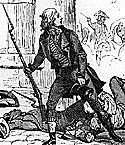 The reactions to the brief revolt were swift and dramatic
Napoleon, an obscure twenty-six-year-old General without
portfolio, was made commander of the Army of the Interior. The
Royalist revolt melted away; d'Artois again set sail for sanctuary
in England and Pichigru remained loyal to the Revolution (for the
time being). Laffont and other rebel leaders were guillotined.
The reactions to the brief revolt were swift and dramatic
Napoleon, an obscure twenty-six-year-old General without
portfolio, was made commander of the Army of the Interior. The
Royalist revolt melted away; d'Artois again set sail for sanctuary
in England and Pichigru remained loyal to the Revolution (for the
time being). Laffont and other rebel leaders were guillotined.
Napoleon would soon meet Josephine while touring the salons as a hero. The Italian campaign and more glory lay ahead, but for now he was the celebrity of the moment. All this may not have come as a surprise to the future Emperor. He had foretold his success two years before when jailed at Antibes. He wrote to his brother Lucien, "Have patience; in a little time I shall conmand Paris."
Back to Empire, Eagles, & Lions Table of Contents Vol. 2 No. 14
Back to EEL List of Issues
Back to MagWeb Master Magazine List
© Copyright 1995 by Emperor's Headquarters
This article appears in MagWeb (Magazine Web) on the Internet World Wide Web.
Other military history articles and gaming articles are available at http://www.magweb.com
